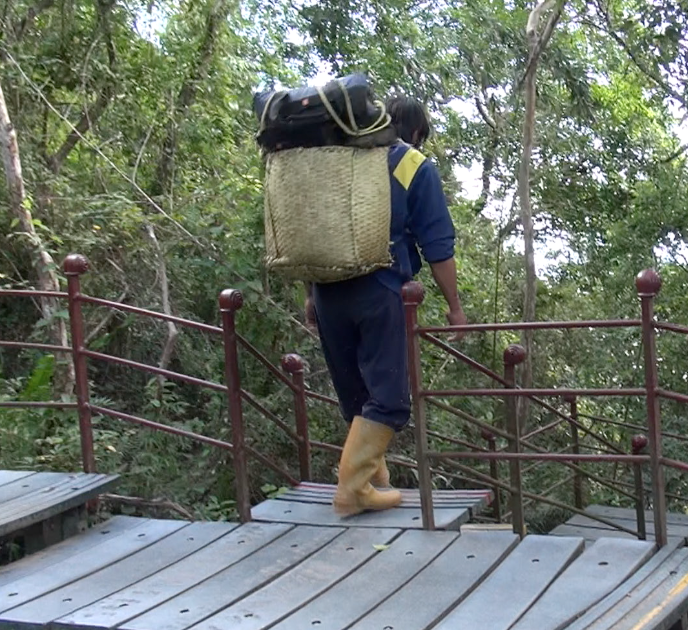In the United States and throughout the world national parks are facing another dilemma: how to respect the special claim of indigenous peoples on park lands while opening them to all the citizens of the world.
The picture above becomes understandable once we understand its context. The pathway here is the Shakadang Trail in Taiwan's Taroko National Park, one of the most famous park trails in the world, cut in a cliff to allow travelers a superb view of the river below. The man on the motor scooter is a member of the Taroko tribe, one of several indigenous groups in Taiwan. The sign below explains why this particular scooter came motoring down the trail in November, 2014, when I was one of the hikers on the trail. I stepped aside, snapped the picture above, and watched the scooter disappear down the trail. A sign on the trail explained what I had just seen -- and was a model of compromise: yes we were in a park, but yes also we were passing through "an aborigine reserve land," and the indigenous Tarokos needed to "transport goods" on the trail, but yes again, we walkers also had our rights, and so the Tarokos would do their best to scoot by at designated times.
Like the Taiwanese, American park administrators are engaged in bringing indigenous life into sharper focus in our own parks. In my course at Eastern Washington University on the "History of the American National Parks" my students and I explore a variety of themes in park history including the place, over the years, of indigenous peoples in the parks. As the United States approaches the centennial of the Organic Act (1916), which laid the foundation for the park system, park planners are assessing the history and future of the Native American presence in the parks.
One of the first American parks was intrinsically about indigenous peoples--the ancient Americans who built and then abandoned their dwellings in what is now Mesa Verde National Park.
At Mesa Verde the past of an indigenous people is the essential story -- the park's reason for coming into existence in the first place. That said, the indigenous story continues to unfold. At a site where, in the distant past, unregulated "pot hunters" used dynamite among the ruins, hoping to unearth treasures; in contrast, today the regulations on movement through the park are increasingly strict. Heavy fines are imposed on individuals who wander off trails into sites which might contain more artifacts. I listened to a talk at Mesa Verde in 2012 where the ranger told us that as a boy he (and anyone else) had free access to sites that today -- even as a ranger -- he cannot hike.
At other parks the Indian presence in the parks has usually been more marginal or misunderstood. Take for example this Indian artifact at Lake MacDonald Lodge in Glacier National Park.
One of the first national parks, Glacier was famous in the early days for the "Glacier Park Indians." Along with the mountains they were billed as one of the attractions of the National Park: come here and see real Indians. Although they were in actuality local Blackfeet Indians, their regalia and dances were a fantasy version of indigenous culture designed to entertain rather than educate.
That is changing now in Glacier and other national parks. At Glacier Blackfeet Indians tell stories in summer programs. There and elsewhere the national park shops often feature books about Native Americans and the parks, including Robert Keller and Michael Turek's American Indians and National Parks. The park service has created a American Indians Liaison Office whose activities include seeking to "create a process that could enable a Federally-recognized tribe to enter into an agreement with a park regarding the gathering of certain culturally important plants and minerals."
Taroko's Lessons in Embracing Indigenous Peoples in a Park Culture
While visiting Taroko National Park this fall, I was impressed by the ways that the Taroko people were a part of the park story and the park presence in Taiwan. And more was involved than those motor scooters on the Shakadang trail.
After that motor scooter went by, fellow hiker Jonathan Butler continued along the trail. Jonathan is a professor at Taipei's Soochow University and had sponsored me for a talk I would be giving on "National Parks: The International Experience." On our visit to Taroko I was looking for park features that I could incorporate into my talk in Taiwan. In the park I saw many ways that Taiwan is addressing challenges common to parks in the United States and elsewhere, such as how best to build trails, manage traffic, and provide signage. There was lots to learn, but best of all was Taroko lessons in the way a park can embrace indigenous persons in its culture.
At the point where the Shakadang trail comes down to the river, you arrive at a place where Taroko men and women run several shops selling food and drink as well as native crafts:
Jonathan Butler and I took another hike in Taroko National Park, this time climbing a trail up the side of the gorge towards a Taroko village. Earlier I had taken this picture of showing a Takoro carrying a basket as a back pack.
(You know you want to!)
If you enjoyed this article you may enjoy these other articles about Parks and Mother Nature:
• A Visit to John Muir National Historic Site
• Danger in the National
• Henry David Thoreau and the Felling of a "Noble Pine"
• On the Road with History 498: "The History of the American National Parks"
• New York's Central Park: A Wilderness?








 RSS Feed
RSS Feed